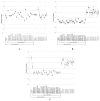Prader-Willi Syndrome: Obesity due to Genomic Imprinting
- PMID: 22043168
- PMCID: PMC3137005
- DOI: 10.2174/138920211795677877
Prader-Willi Syndrome: Obesity due to Genomic Imprinting
Abstract
Prader-Willi syndrome (PWS) is a complex neurodevelopmental disorder due to errors in genomic imprinting with loss of imprinted genes that are paternally expressed from the chromosome 15q11-q13 region. Approximately 70% of individuals with PWS have a de novo deletion of the paternally derived 15q11-q13 region in which there are two subtypes (i.e., larger Type I or smaller Type II), maternal disomy 15 (both 15s from the mother) in about 25% of cases, and the remaining subjects have either defects in the imprinting center controlling the activity of imprinted genes or due to other chromosome 15 rearrangements. PWS is characterized by a particular facial appearance, infantile hypotonia, a poor suck and feeding difficulties, hypogonadism and hypogenitalism in both sexes, short stature and small hands and feet due to growth hormone deficiency, mild learning and behavioral problems (e.g., skin picking, temper tantrums) and hyperphagia leading to early childhood obesity. Obesity is a significant health problem, if uncontrolled. PWS is considered the most common known genetic cause of morbid obesity in children. The chromosome 15q11-q13 region contains approximately 100 genes and transcripts in which about 10 are imprinted and paternally expressed. This region can be divided into four groups: 1) a proximal non-imprinted region; 2) a PWS paternal-only expressed region containing protein-coding and non-coding genes; 3) an Angelman syndrome region containing maternally expressed genes and 4) a distal non-imprinted region. This review summarizes the current understanding of the genetic causes, the natural history and clinical presentation of individuals with PWS.
Keywords: Angelman syndrome; Prader-Willi syndrome; clinical presentation and differences; deletion; genetic subtypes.; genomic imprinting; maternal disomy.
Figures




References
-
- Whittington J, Holland A, Webb T, Butler J, Clarke D, Boer H. Cognitive abilities and genotype in a population-based sample of people with Prader-Willi syndrome. J. Intellect. Disabil. Res. 2004;48(Pt 2):172–187. - PubMed
LinkOut - more resources
Full Text Sources
